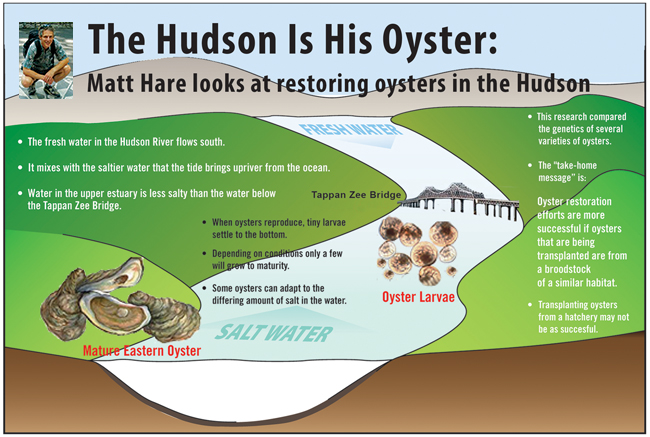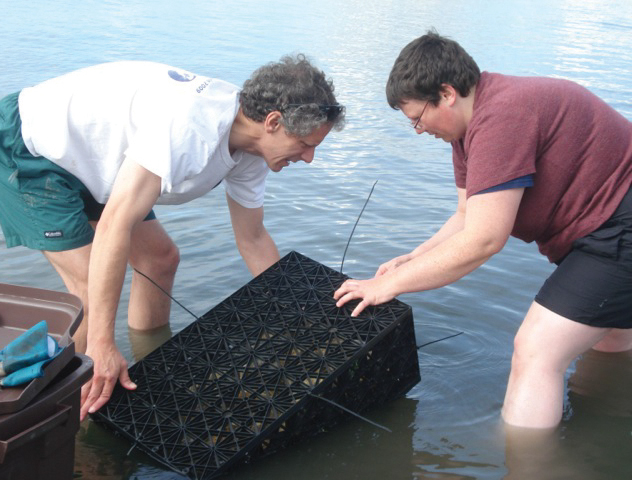
Genomic Analysis of Oyster Dispersal and Recruitment Success, a New York Sea Grant research project by Dr. Matthew P. Hare, Department of Natural Resources, Cornell University.
Oysters were once so plentiful in New York City that oyster shuckers worked nearly ‘round the clock, feeding rich and poor alike, discarding mountains of shells. Not now.
But there is much interest in restoring oyster populations. Some habitats targeted for restoration are at the geographic and environmental edge of the oysters’ ecological niche in low salinity waters of the Hudson estuary above the Tappan Zee Bridge.
In Sea Grant-funded research, Matthew Hare of Cornell has been looking at two important genetic questions that affect plans to restore oysters in the Hudson: Is there gene flow between lower and upper estuary oyster populations low enough to cause genetic structure? And secondly, are low salinity oyster populations locally adapted by functional genetic differences, or do they survive extreme conditions by virtue of acclimating to the conditions?
Hare has studied these questions in Delaware Bay and Hudson River oysters using a combination of genomic approaches applied to gene expression and genomic polymorphism. In other words, for oysters, the size and shape matter.
What he found was genetic differences between the fresher upper the Hudson compared to the saltier lower Hudson estuary. The research team found genomic patterns consistent with limited gene flow exist between upper and lower estuary populations. This implies that local adaptation may be more multigenerational. This means in order to restore oysters using hatchery-produced oysters and ensure that they will produce viable offspring, restoration programs should use broodstock collected from a habitat that matches the planned restoration habitat.
“The goal of oyster restoration efforts in the Hudson-Raritan Estuary
and elsewhere is to jump-start a population recovery," says Hare. "By improving
habitat or using hatcheries to supplement the population it is hoped
that a little effort now will promote and hasten natural recovery."
— Barbara A. Branca

Matt Hare and Harmony Borchardt-Wier anchoring a cage of experimental oysters along the East River, Bronx, NY. Photo by Sarah Crestol.
More Info: New York Sea Grant
New York Sea Grant (NYSG), a cooperative program of Cornell University
and the State University of New York, is one of 33 university-based
programs under the National Sea Grant College Program (NSGCP) of the
National Oceanic and Atmospheric Administration (NOAA). The NSGCP
engages this network of the nation’s top universities in conducting
scientific research, education, training and extension projects designed
to foster science-based decisions about the use and conservation of our
aquatic resources. Through its statewide network of integrated
services, NYSG has been promoting coastal vitality, environmental
sustainability, and citizen awareness about the State’s marine and Great
Lakes resources since 1971.
New York Sea Grant maintains Great Lakes offices at SUNY Buffalo, the
Wayne County Cooperative Extension office in Newark and at SUNY Oswego.
In the State's marine waters, NYSG has offices at Stony Brook University
and Stony Brook Manhattan, in the Hudson Valley through Cooperative
Extension in Kingston and at Brooklyn College.
For updates on Sea Grant activities:
www.nyseagrant.org has RSS,
Facebook,
Twitter, and
YouTube links. NYSG also offers a free e-list sign up via
www.nyseagrant.org/coastlines for its flagship publication,
NY Coastlines/Currents, which is published several times a year.